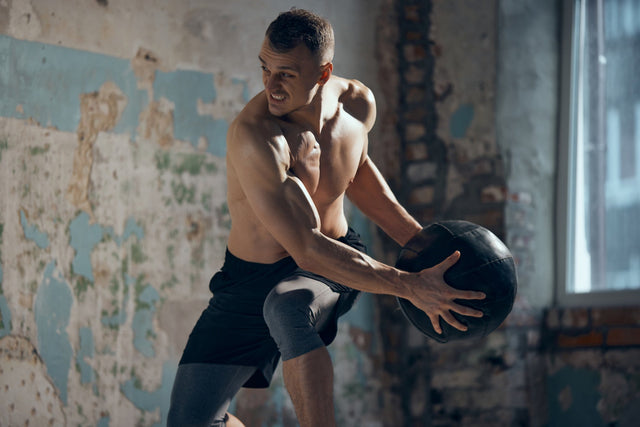There’s a simple way you can prevent fatigue and muscle cramps during exercise - proper nutrition. Well, that’s just one small part of it. Although there’s more to muscle cramps and fatigue, proper hydration and performance nutrition can help in a big way. When you cut calories and don’t drink enough water, your performance will inevitably suffer, often resulting in dehydration, causing muscle and mental fatigue, as well as muscle cramps. We’re going to cover the most common ways how you can prevent fatigue and muscle cramps.
What Causes Muscle Cramps
The exact causes of muscle cramps are not completely elucidated; however, research has shown that chances of muscle cramps can increase due to several factors, including mineral and electrolyte imbalances, muscle tightness, excessive exercise, and dehydration. Low levels of electrolytes, such as magnesium, potassium, calcium, sodium, and chloride, help muscle contraction, therefore it is thought that a lack of minerals and electrolytes can lead to muscle cramp to not contract as intended.
Exercise associated muscle cramps are the most common. High-intense physical exercise and excessive heat can cause muscle fatigue and cramping. Most muscle cramps are harmless; however, they can last between only a few seconds to a few minutes.
When the human body gets hot, the nervous system needs to regulate the temperature change, which encourages the body to begin to sweat. When our bodies perspire, we deplete our body’s water levels, and with the loss of water, comes the reduction of important things in water, such as electrolytes.
Cramps really depend on a person’s pathological condition. For example, leg cramps in pregnant women are very common, affecting around 50% particularly in the last 3 months and at night [R].
Muscle cramps in those with Cirrhosis are very prevalent affecting around 88% of the patient population. Other disease states that have a high prevalence of cramping, include fibromyalgia, diabetes, and renal disease.
Muscle cramps are most commonly caused by
- Impedance of blood flow: Narrowing of the arteries can cause cramping in the legs during exercise, due to the increased blood flow and oxygen required for aerobic and anaerobic exercise. This is also common amongst those who experience nocturnal cramps.
- Nerve compressions is also a cause of muscle cramping. When nerves compress in the spine, they can also cause cramping.
- Loss of minerals, such as potassium, calcium, or magnesium is one of the leading causes of muscle cramps during exercise.
- A disease pathology, such as cirrhosis, fibromyalgia, diabetes, or renal disease.
How To Reduce Muscle Cramps During Exercise
The easiest way to reduce muscle cramps during exercise, is proper hydration and nutrition.
Food contains sodium, or salt, and provides the electrolytes your body needs for proper muscle contraction and hydration. If you do not get an adequate amount of sodium and electroyltes through food, dietary supplements with electrolytes such as Swolverine’s INTRA, can also help reduce the chances of muscle cramps and fatigue during exercise.
Eating potassium rich foods, such as kiwi, guava, grapefruit, and avocado, can also aid in preventing or reducing muscle cramps.
What Causes Muscle Fatigue
When we talk about fatigue, in relation to exercise, there are two different types: muscle fatigue and exercise fatigue, otherwise known as over training.
Exercise fatigue refers to a serious drop in power and performance over time, often resulting in burnout. This is also known as overreaching or over training. Factors such as overheating and dehydration throughout workouts, inadequate rest and recovery, suboptimal nutrition, and lack of proper supplement protocol are all potential factors, which can accumulate and attribute to extreme exercise fatigue.
Muscle fatigue is caused by a buildup of lactic acid, which causes a loss of muscle power.
To fully understand muscle fatigue, however, you first need to understand how the body utilizes energy while you exercise.
Aerobic vs Anaerobic Pathway
Your body utilizes energy in two distinct ways; aerobic vs anaerobic. Aerobic, means with oxygen, therefore while you’re training in an aerobic state, your body has a sufficient amount of oxygen to provide the energy which is necessary to sustain an exercise for a prolonged period of time, without tapping into other energy reserves.
Any low to moderate steady-state exercise is considered aerobic. Steady-state exercise can be things like walking, running, cycling, and even climbing stairs.
The aerobic pathway produces a significant amount of energy and utilizes all three macronutrients: carbohydrates, fats, and protein for fuel.
When the oxygen supply can’t simply keep up with your body’s energy demands, different energy supplies will be utilized, thus transitioning into an anaerobic state.
The anaerobic pathway of energy metabolism is the creation of energy without oxygen. This typically takes place when an activity is performed at a high enough intensity, that your body can’t provide the necessary oxygen to keep up with energy demands alone.
Without oxygen, the body relies upon adenosine triphosphate (ATP) and glucose or glycogen in the muscle cells for energy, comprising what’s called the phosphagen (immediate) energy system and glycolytic pathway to produce energy in limited quantities.
Creatine can significantly increase phosphoryl creatine intramuscular stores. It has been shown to improve the energy supply from the phosphagen systems, thereby increasing the maximum capacity to resynthesize adenosine triphosphate (ATP) by non-oxidative pathways, leading to improved performance, strength, and power [R].
RELATED ARTICLE The Definitive Guide To Kre-Alkalyn Creatine
When exercise intensity increases the glycolytic system is in full force, and the mitochondria are trying to keep up with the amount of pyruvate that is being produced. This process leads to the conversion of pyruvate to lactate (lactic acid), which can take anywhere from 10-90 seconds depending upon workout intensity, producing a significant number of H+ (hydrogen ions) which are expelled into the bloodstream. When you’ve reached this type of exercise intensity, your body can’t keep up for long.
This is where buffering lactic acid, can help improve your training performance and workout volume. Well, in fact, your body has a natural buffering system, including sodium bicarbonate, phosphate, and carnosine. This is where Carnosyn® Beta-Alanine powder supplements can help provide performance improvements during high-intensity training, as well as Kre-Alkalyn, since we add sodium bicarbonate for to help delay muscle fatigue.
RELATED ARTICLE How To Prevent Lactic Acid Build-Up In Your Muscles
How To Prevent Fatigue
- Here are a few ways to prevent fatigue, from becoming a recurring issue.
- Drink plenty of water and hydrate throughout the day.
- Supplement with electrolytes as well as performance supplements, such as beta-alanine and kre-alkalyn to naturally buffer lactic acid.
- Include lean proteins, healthy fats, and complex carbohydrates into your nutrition plan, with a focus on hydrating and potassium rich foods.
- Take rest days, and make sure to have a nightly routine, to get high-quality sleep to prevent burnout.
How To Prevent Fatigue And Muscle Cramps During Exercise: Takeaway
Muscle cramps are benign in nature and won’t cause any harm. Besides taking you out of the race on competition day, which would be a total bummer. The problem with muscle cramps, is that the exact etiology is not well understood. They happen and often there is no explanation. The best way to prevent muscle cramps and fatigue, is through adequate hydration and performance nutrition. What you eat is critical in how your body performs. Food is fuel and without the proper nutrition, your performance will suffer. Eat lean protein, healthy fats, and complex carbohydrates, to initiate muscle protein synthesis and glycogen replenishment. Dietary supplements, can also help improve exercise performance and delay muscle fatigue.







